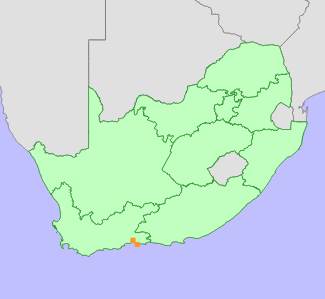|
Scientific Name | Disa procera H.P.Linder |
Higher Classification | Monocotyledons |
Family | ORCHIDACEAE |
Synonyms | Disa excelsa in sense of Lindl. 1838, not of Thunb. (misapplied name), Herschelia excelsa in sense of Rolfe (1913), not of (Thunb.) Kraenzl. (misapplied name) |
National Status |
Status and Criteria | Endangered B2ab(i,ii,iii,iv,v); C2a(i); D |
Assessment Date | 2015/04/28 |
Assessor(s) | L. von Staden, D. Turner & D. van der Colff |
Justification | EOO of less than 5 km² and AOO of less than 0.5 km² and only known from two subpopulations, each consisting of less than 100 mature individuals. It continues to decline due to ongoing habitat degradation. This is caused by a lack of fire and competition from alien invasive plants. |
Distribution |
Endemism | South African endemic |
Provincial distribution | Western Cape |
Range | Sedgefield. |
Habitat and Ecology |
Major system | Terrestrial |
Major habitats | Knysna Sand Fynbos, Goukamma Dune Thicket |
Description | Coastal dune fynbos. |
Threats |
| This species is endemic to Southern Cape Dune Fynbos, a vegetation type occurring on the coast between Wilderness and Knysna, and which is already at least 40% transformed, primarily due to expanding coastal development, but also agricultural expansion and forestry plantations. Large parts of this vegetation type is also densely infested with invasive alien plants (wattles).
One subpopulation occurs on a site that has not burnt for more than 41 years (D. Turner pers. obs.), and the coastal dune fynbos is turning into impenetrable thicket in places. Most orchid species benefit from fires, often flowering profusely in response to fire, while remaining dormant when vegetation becomes very dense. A number of Disa species have become locally extinct in sites where fires have been excluded for very long periods of time.
An additional threat is the continued spread of alien invasive plants, particularly naturalized exotics from surrounding properties, into this species habitat, some of them very difficult to control and eradicate.
A second subpopulation occurs on a tiny fragment of public land, that is degraded due to inappropriate management, and threatened by spreading alien invasive plants. |
Population |
Disa procera is a very rare species, and remained poorly known due to taxonomic confusion (Linder 1981, Linder 1999 and Bytebier et al. 2008). There are few historical collections, and the former range of this species is not known. Currently, it is known from two subpopulations. One occurs within a 170 ha fragment of Southern Cape Dune Fynbos, where annual surveys conducted since 2006 have mapped the extent of the subpopulation and recorded less than 100 plants. A second subpopulation was discovered on a small fragment in 2014, where there is also about 100 plants. Both are impacted by ongoing habitat degradation.
|
Population trend | Decreasing |
Assessment History |
Taxon assessed |
Status and Criteria |
Citation/Red List version | | Disa procera H.P.Linder | EN B2ab(i,ii,iii,iv,v); C2a(i); D | 2015.1 | | Disa procera H.P.Linder | CR D | Raimondo et al. (2009) | | Disa procera H.P.Linder | VU D2 | Victor (2002) | |
Bibliography |
Bytebier, B., Bellstedt, D.U. and Linder, H.P. 2008. A new phylogeny-based sectional classification for the large African orchid genus Disa. Taxon 57(4):1233-1251.
Liltved, W.R. and Johnson, S.D. Unpublished. The Cape Orchids - Wild orchids of the Cape Floral Kingdom.
Linder, H.P. 1981. Taxonomic studies in the Disinae. VI. A revision of the genus Herschelia. Bothalia 13(3 & 4):365 - 388.
Linder, H.P. 1999. Disa. In: H.P. Linder and H. Kurzweil (eds.), Orchids of southern Africa (pp. 187-288), A.A. Balkema, Rotterdam.
Raimondo, D., von Staden, L., Foden, W., Victor, J.E., Helme, N.A., Turner, R.C., Kamundi, D.A. and Manyama, P.A. 2009. Red List of South African Plants. Strelitzia 25. South African National Biodiversity Institute, Pretoria.
Victor, J.E. 2002. South Africa. In: J.S. Golding (ed), Southern African plant Red Data Lists. Southern African Botanical Diversity Network Report 14 (pp. 93-120), SABONET, Pretoria.
|
Citation |
| von Staden, L., Turner, D. & van der Colff, D. 2015. Disa procera H.P.Linder. National Assessment: Red List of South African Plants version 2024.1. Accessed on 2025/12/13 |
 Comment on this assessment
Comment on this assessment


